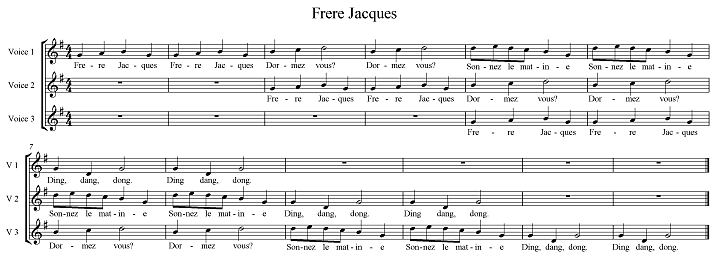
Round and Round
Whenever the word harmony is mentioned, thoughts of chords spring to mind. However, the simplest way of introducing harmonic music (notes which sound good when played together) is to start with Rounds. A round, is a form of music where a tune begins in one voice, then a second voice starts the tune a short while later, then a third voice begins... and so on. One of the most well known rounds would probably be Frère Jacques:
Listen to (and perform) the music of Frère Jacques and decide where the good sounding harmonies are (Concords) and the not so good sounding harmonies occur (Discords). Generally the concords are where distances between the notes are 3, 5 and 8 notes apart (e.g. G-B, A-C, B-D, G-D), and the discords are where the distances are 2 and 4 notes apart (e.g. C-D, A-D).
Here is a section from the rhythmic melody encountered earlier, this time with thirds added (3 notes apart). The thirds have been coloured red so that you can see where they occur:
Compose a new melody (or use one you created earlier) and add harmony notes. Either enter the new notes on the same stave as the melody, or (even better) create a new stave to write the harmony notes. If you use a new stave for the harmony, you can experiement with using different sounds for each part. When you have entered all the harmony notes, listen to your music again and see if there are any other distances which sound good. Also, decide if a few discords make the music sound better or worse. Are there any points in the music where you should always use concords? Are there any points in the music where it seems discords should go?
| Back>Form 2... | |